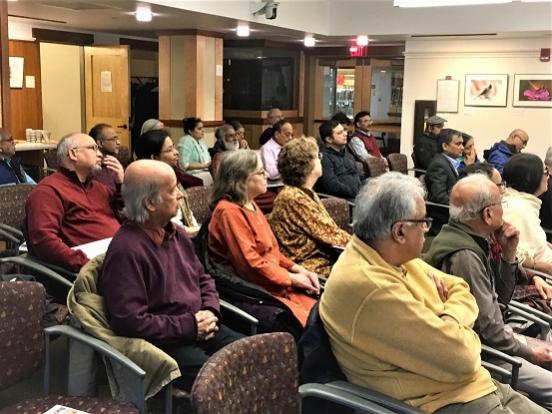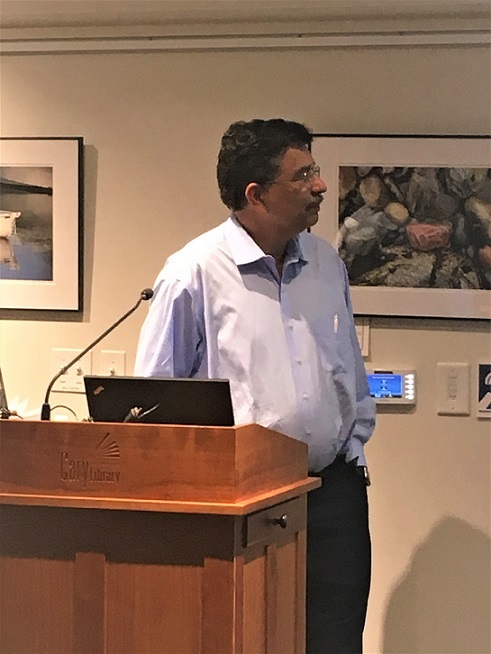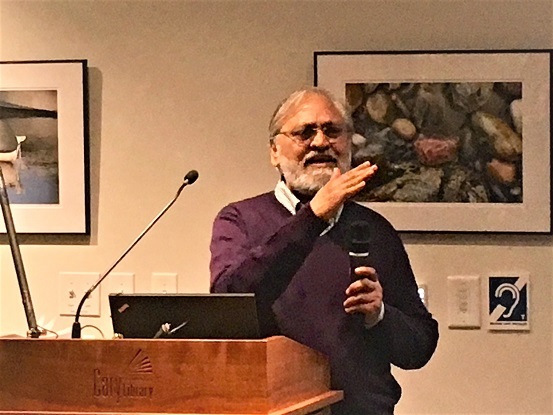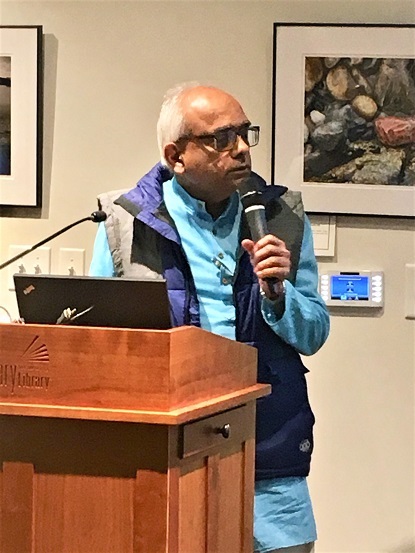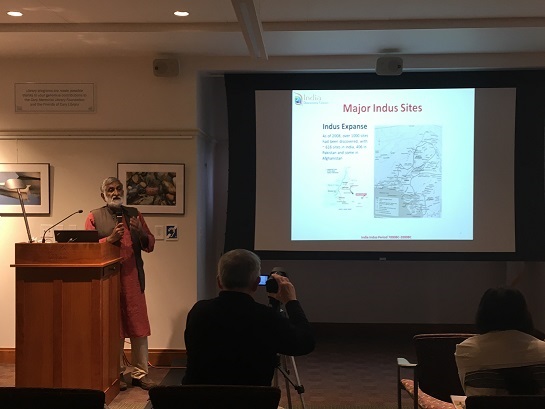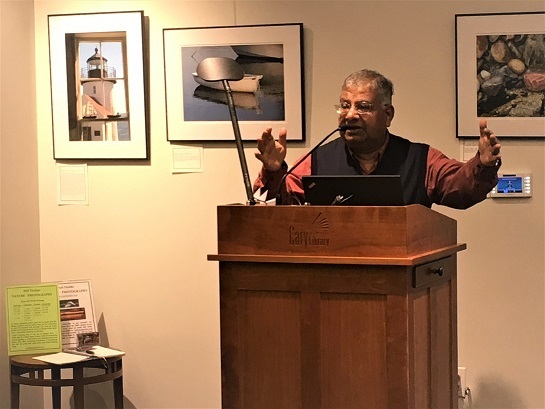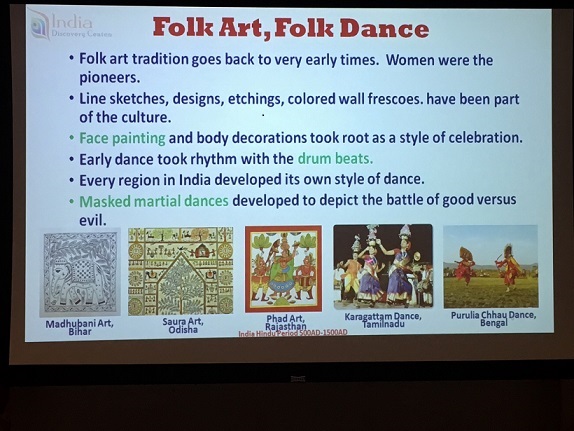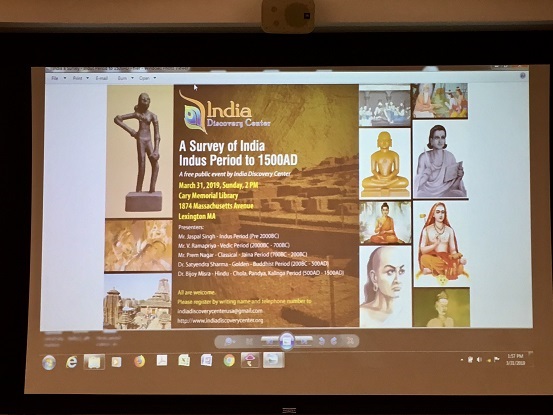Contribute
| Evolution Of Indian Culture From The Indus Period To 1500AD |
V. S. Ramapriya
04/11/2019
Indian land is vast and India’s history winds through many curves. Through time, India developed a unique signature in world civilization through experiments on group living, allowed diversity of opinions and cared for art and literature as expressions of human freedom. India Discovery Center of Lincoln, MA, hosted an afternoon seminar entitled “A Survey of India – Indus Period to 1500AD†at Cary Memorial Library in Lexington, MA on Sunday, March 31. The balmy weather and the library ambiance became an excellent setting to traverse through five thousand years of India’s history. There were five presentations: Indus Period by Jaspal Singh, Vedic Period by V. S.Ramapriya, Classical Period 700BC-200BC by Prem Nagar, Golden Period 200BC-500AD by Satyendra Sharma and Hindu Period 500AD-1500AD by Bijoy Misra. Each presentation was followed by a short Q&A session. A handout containing the presentations was distributed. Jaspal Singh started the seminar with a summary of the Indus Period. Agrarian revolution led to self-contained settlements in more than a million kilometers area from Turkish Iranian border to south India. It gave rise to urban revolution with the establishment of large cities (a square kilometer). About a thousand sites have been excavated in the Indus-Saraswati river plains. The economy was agricultural with trade centers and other industrial production like beads and seals. Surplus was traded in far and distant places. Raw materials were sassembled from different parts of India and outside. Innovations were made in construction and engineering leading to urbanization. Standardization developed. Water management and irrigation techniques helped agriculture. Indus script unfortunately has not yet been deciphered. We do not know who the people were. DNA from Rakhigarhi matches with indigenous Irulia people in South India. Mother goddess seems to be the deity and the society can be inferred to be matriarchal. This great civilization collapsed due to long-period drought, drying up of rivers and geological shifting of the river beds. There was a question on the volcanic eruptions to cause the shift, but no evidence is found. There was a comment connecting the female deity to the organization of the town and society. The Indus Period gave India the traits of industry and innovation. V. S. Ramapriya followed with the Vedic Period. The Vedic Period has left behind a unique “Time Capsule†in the form of the Vedas. The latter has been preserved orally for thousands of years. The Vedas enunciate an ‘Universal Order’ that helps to distinguish between sat (Permanent existence) and asat (temporary existence)’ The Vedic mantras were grouped together into hymns and were compiled as compositions called suuktas. Vedic language helped evolve the classical Sanskrit that developed several millenia later. The Vedic hymns were religious invocations and were recited to obtain grace from the celestial gods. The ritualism was deeply set in with elaborate arrangements for the construction of the sacrificial fire and the preparation of the offerings. There was some understanding of the space and weather, and deep analysis of human mind and speech. Vedic people were in conflict with their neighbors and wars were a common occurrence. Kings, royals and villages are mentioned in the social structure. Though no known script is discovered, the depth and volume of material are bewilderingly large. Vedic Period gave India the traits of language and organization. The next presentation was on the Classical Period 700BC-200BC by Prem Nagar. The upanisads established a human-centered belief system leading to personal accountability. The elements of accountability, called karma became the topic of analysis in the philosophical systems leading to social and behavioral theories. An important contribution was the Jaina faith system which built itself on the model of a stationary universe. Non-violence and non-possessiveness were championed by the Teacher Mahavir. The Buddha followed with his own theories of social conduct based on friendship and compassion. Along with the Vedic principles, these became the foundation of Indian culture. The Period saw the unique development of codification, leading to progress in mathematics, grammar, art, music and dramatics. Panini’s grammar of human speech became the foundation of all grammars in the world. Speech was coded through syllables and eventually with scripts representing the syllables. The economist Kautilya compiled a detailed treatise on the operation of the State and the social system defining the duties and roles for all components. India developed into an opulent nation following Kautilya’s model The presentation had a question on the ancestry of milk production and another on untouchability. The Classical Period gave India the traits of literature and conduct. Satyendra Sharma followed with the presentation for the Golden Period 200BC-500AD. Vedic rituals were questioned and life & living were examined through knowledge discussions. The six systems of Philosophy were put to practical use by free exchange of ideas among different religions and schools of thought. Freedom of expression and thought brought about development of different strands in religions. Different faith systems mutually coexisted. Different sects developed. There was proliferation of secular literature. Creation of open schools gave access to education to all without consideration of caste and wealth. This was a period of significant advances in medicine, technology, mathematics, art and astronomy. Ajanta produced world class art and rock cut temples. Ayurveda and herbal medicine supported good health. The regional cultures developed and thrived as a result of decentralization of empirical power. The Period gave India the traits of analysis and aesthetics. The last presentation on the Hindu Period 500AD-1500AD was by Bijoy Misra. The Period is known for its rapid expansion into the use of iron technology and construction of large temples. Trade in far-away lands in textile, food products and jewelry created an opulent life style of luxury, sophistication and high level of taste in life. Poetics were coded and musicology developed. India became a nation of art, music, dance and drama. The period was particularly influenced through the philosophy of equality presented by the Saint Shankara. This made India a knowledge center where each view had its place and its respect. While the freedom led to creation of diverse literature, sectarianism brought rivalry among people. With reduced central administration, India became a target by the Islamic invaders to pounce in and plunder. Gradually the great nation lost its ground and was occupied by foreign rulers. The Period gave India its traits on art and design. In his closing remarks, Dr. Misra announced the schedule of the next Seminar to be held on 4th May, 2019 on the Moghul and Maratha Period 1500 – 1800AD. Registration is invited through https://www.indiadiscoverycenter.org
You may also access this article through our web-site http://www.lokvani.com/
